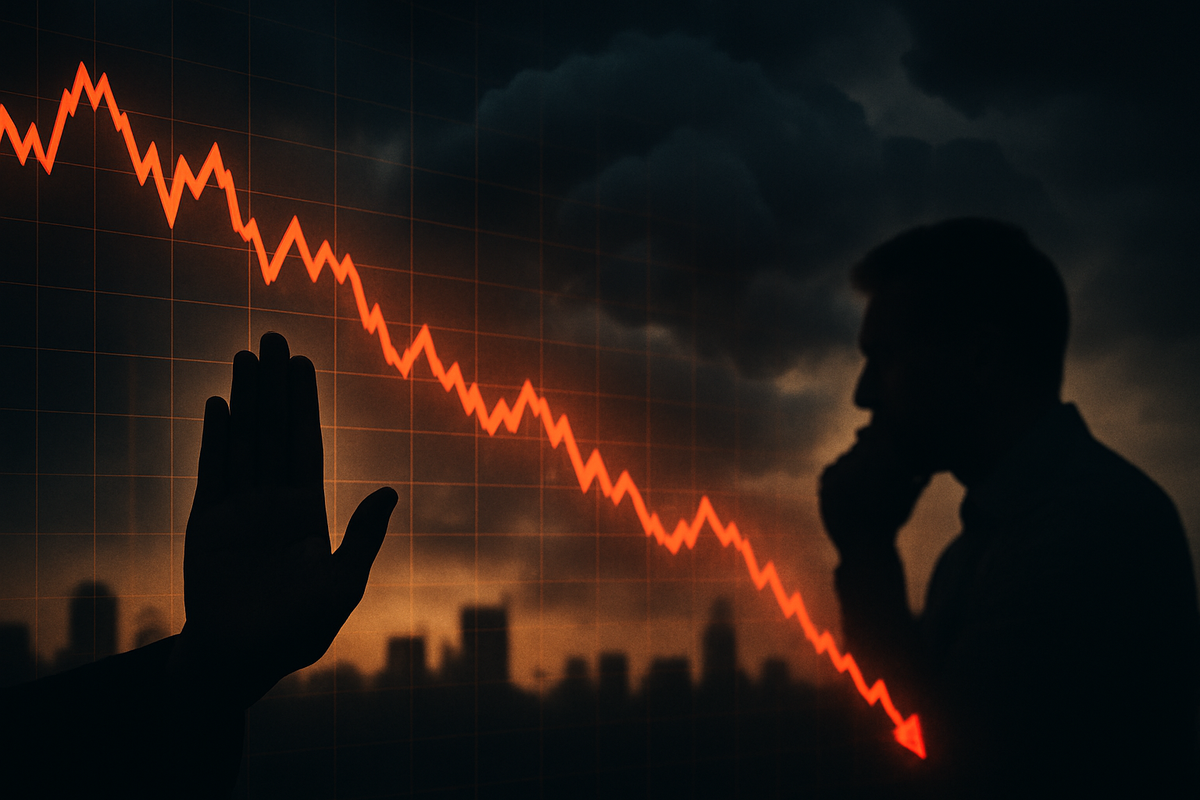
Jamie Dimon, the influential CEO of JPMorgan Chase (NYSE: JPM), has once again sounded the alarm, warning of a potential "serious correction" in the U.S. stock market within the next six months to two years. His latest pronouncements, delivered in October 2025, suggest a growing unease among some of the financial sector's most seasoned leaders, prompting investors to re-evaluate the sustainability of current market valuations amidst a complex global landscape. While market reactions to Dimon's previous warnings have often been surprisingly resilient, his consistent caution serves as a potent reminder of underlying risks that may be overlooked by a largely bullish Wall Street.
Dimon's Unwavering Caution Amidst Market Highs
JPMorgan Chase CEO Jamie Dimon has been a consistent voice of caution regarding the health of the U.S. economy and stock market for several years, with his most recent warnings in October 2025 echoing concerns he has articulated since late 2023. In an interview with the BBC, Dimon stated he was "far more worried about the correction than others," citing a cocktail of geopolitical tensions, heavy fiscal spending, and global remilitarization as key drivers of uncertainty. He acknowledged the significant role of artificial intelligence (AI) in propelling recent market growth but cautioned against "unrestrained optimism," predicting that some AI investments would "probably be lost." Separately, in an interview with Bloomberg, Dimon characterized the current environment as a "bull market" but underscored that asset prices were high and credit spreads unusually tight, signaling "overconfidence." He further expressed nervousness about inflation not receding as quickly as many expect and conceded that a recession "could happen" in 2026.
This latest warning follows a pattern of increasingly pointed assessments. In May 2025, during JPMorgan's annual investor day, Dimon delivered a "blunt assessment," emphasizing that markets were underestimating a range of mounting risks, including elevated inflation and stagflation. He specifically warned about deteriorating U.S. credit quality, stating that "credit today is a bad risk" and that credit spreads were not adequately accounting for recession risk and higher rates. He even suggested that potential tariffs could trigger a "10% market correction" as companies slash earnings forecasts. Earlier in April 2024, his annual letter to shareholders outlined a "chilly scenario" where interest rates could climb to 8% or higher, significantly lowering the odds of a "goldilocks soft landing." He warned of potential "carnage" for both equity and debt investors if a higher-rate scenario materialized.
The timeline of Dimon's warnings reveals a persistent concern about "stickier" inflation and higher interest rates than markets anticipate, a theme he has championed since October 2023, when he advised investors to brace for rates potentially reaching 7%. Key players in this ongoing narrative include Dimon himself, as a leading voice in the financial industry, and JPMorgan Chase, which often provides market insights through its earnings reports and investor communications. The broader financial markets, including institutional investors, hedge funds, and retail traders, are the primary stakeholders, constantly weighing Dimon's influential commentary against prevailing bullish sentiment. While immediate market reactions have often seen indices like the S&P 500 continue to climb after his predictions, his warnings invariably prompt a deeper re-evaluation of risk, especially among those who value his long-term perspective.
Potential Winners and Losers in a Corrective Market
A significant stock market correction, as warned by Jamie Dimon, would undoubtedly create a landscape of both winners and losers across various sectors and public companies. Companies with strong balance sheets, consistent free cash flow, and defensive business models are typically better positioned to weather economic downturns and market volatility. This includes established consumer staples companies like Procter & Gamble (NYSE: PG) or utilities such as NextEra Energy (NYSE: NEE), which tend to see stable demand regardless of economic cycles. Furthermore, financial institutions with robust capital reserves and stringent lending practices, like JPMorgan Chase (NYSE: JPM) itself, could potentially benefit from market dislocations by acquiring distressed assets or gaining market share if competitors falter. Technology companies focused on essential enterprise solutions rather than discretionary consumer spending, particularly those with recurring revenue models, might also prove more resilient.
Conversely, sectors and companies that have seen substantial valuation expansion based on future growth potential, often with little current profitability, stand to lose the most. High-growth technology stocks, particularly those in nascent AI sectors that Dimon specifically mentioned as prone to "lost" investments, could face significant pressure. Companies with high debt loads or those heavily reliant on easy credit and low-interest rates for expansion would also be vulnerable as borrowing costs rise and credit markets tighten. Discretionary consumer sectors, such as luxury goods or travel and leisure companies like Marriott International (NASDAQ: MAR) or LVMH Moët Hennessy Louis Vuitton (OTC: LVMUY), could see demand plummet if consumer confidence eradicates and spending tightens. Furthermore, companies with significant exposure to geopolitical risks or those heavily impacted by potential tariffs, as Dimon noted, could experience substantial earnings revisions and stock price declines.
The real estate sector, particularly commercial real estate and highly leveraged developers, could also face significant headwinds. Rising interest rates increase financing costs, while a slowing economy could lead to higher vacancy rates and reduced property values. Banks with significant exposure to riskier credit segments, especially those Dimon described as having "bad risk" and inadequate credit spreads, could see a deterioration in asset quality and an increase in loan losses. Smaller, less established companies across various sectors, which often lack the financial resilience of their larger counterparts, would also be at a higher risk of struggling or even failing in a sustained downturn. Investors holding highly concentrated portfolios in these vulnerable sectors or speculative assets would likely bear the brunt of any market correction.
Broader Significance and Historical Context
Jamie Dimon's repeated warnings about a potential stock market correction are not isolated pronouncements but rather fit into broader industry trends marked by increasing economic uncertainty and a re-evaluation of monetary policy. His concerns about "stickier" inflation and higher interest rates directly challenge the "transitory" inflation narrative that dominated early post-pandemic discussions and align with a global trend of central banks grappling with persistent price pressures. The Federal Reserve, for instance, has been navigating a delicate balance between curbing inflation and avoiding a recession, and Dimon's view suggests the market might be underestimating the Fed's need to maintain a hawkish stance for longer. This broader trend also includes a shift in global supply chains, increased protectionism, and significant government deficit spending, all of which contribute to the inflationary pressures Dimon highlights.
The potential ripple effects of a correction could be extensive, impacting not only public companies but also private markets, venture capital, and even global trade. Competitors in the banking sector, such as Bank of America (NYSE: BAC) and Wells Fargo (NYSE: WFC), would undoubtedly feel the pressure, especially if credit quality deteriorates as Dimon suggests. A market downturn could also lead to a flight to quality, potentially benefiting safer assets like U.S. Treasury bonds, while increasing volatility in emerging markets. Regulatory bodies, including the Securities and Exchange Commission (SEC) and the Financial Stability Oversight Council (FSOC), would likely increase their scrutiny of market practices and financial institutions, particularly regarding leverage and risk management, to prevent systemic risks.
Historically, market corrections are a regular feature of economic cycles, and Dimon's warnings draw parallels to periods of economic overheating or speculative bubbles. For instance, the dot-com bubble burst in 2000, or the lead-up to the 2008 financial crisis, both saw periods of "unrestrained optimism" followed by sharp corrections. While the specifics of today's economic environment—such as the unique interplay of AI-driven growth, geopolitical fragmentation, and unprecedented fiscal spending—are distinct, the underlying principles of asset overvaluation, excessive leverage, and underestimation of risk remain potent historical precedents. Dimon's emphasis on credit quality and inflated valuations echoes concerns raised by astute observers before previous downturns, suggesting that while the catalyst may differ, the fundamental vulnerabilities can be similar.
What Comes Next: Navigating the Uncertain Terrain
In the short term, Jamie Dimon's warnings are likely to fuel continued debate among investors and analysts, leading to increased market volatility as participants digest the implications of his outlook. We could see a period of heightened caution, with investors potentially rotating out of high-growth, speculative assets into more defensive stocks or fixed-income instruments. Companies might face pressure to demonstrate clearer paths to profitability and more disciplined capital allocation, especially those that have benefited from a "growth at all costs" mentality. The immediate future may also involve a closer examination of corporate earnings forecasts, particularly for sectors most sensitive to interest rates and consumer spending, as a 10% market correction linked to earnings revisions, as suggested by Dimon, becomes a more tangible threat.
Looking further ahead, the long-term possibilities point towards a potentially more disciplined market environment. If Dimon's predictions materialize, a correction could purge some of the speculative excesses, leading to a healthier, albeit slower, growth trajectory. Strategic pivots will be crucial for companies, requiring a focus on operational efficiency, balance sheet strength, and adaptability to evolving geopolitical and economic realities. Businesses may need to re-evaluate their supply chain resilience and investment strategies, particularly in light of global remilitarization and potential trade tariffs. This period could also present significant market opportunities for patient, well-capitalized investors to acquire quality assets at more reasonable valuations, while challenging those who have relied on sustained market exuberance.
Potential scenarios range from a "soft landing" where inflation gradually subsides without a deep recession, despite Dimon's skepticism, to a more severe "hard landing" characterized by a significant economic contraction and prolonged market downturn. Another scenario involves "stagflation," a recession coupled with persistent high inflation, which Dimon has explicitly warned about. The outcome will largely depend on the interplay of central bank policies, geopolitical developments, and the resilience of corporate earnings. Investors should prepare for a range of outcomes by diversifying portfolios, maintaining adequate liquidity, and focusing on fundamental value rather than speculative trends.
Comprehensive Wrap-Up: A Call for Prudence
Jamie Dimon's repeated and increasingly pointed warnings serve as a critical counter-narrative to the prevailing market optimism, urging investors to exercise prudence in an environment he views as fraught with underestimated risks. The key takeaways from his recent pronouncements include the persistent threat of "stickier" inflation, the potential for higher-for-longer interest rates, escalating geopolitical tensions, and the overvaluation of certain assets, particularly in the tech and AI sectors. His specific concern about deteriorating U.S. credit quality and the possibility of a "10% market correction" driven by earnings revisions highlights tangible risks that could impact investors directly.
Moving forward, the market faces a complex interplay of forces. While the S&P 500 has often demonstrated resilience in the face of Dimon's previous warnings, the cumulative weight of his concerns, coupled with the current global economic landscape, suggests that complacency could be a significant risk. The market's ability to absorb higher rates, manage geopolitical shocks, and sustain earnings growth will be rigorously tested. Dimon's perspective underscores the importance of fundamental analysis and risk management over speculative fervor.
The lasting impact of these warnings, whether or not a severe correction materializes in the exact timeframe he suggests, will likely be a heightened awareness of systemic risks and a more cautious approach to valuation. What investors should watch for in the coming months includes inflation data, central bank communications regarding interest rate policy, corporate earnings reports for signs of credit deterioration or demand slowdowns, and geopolitical developments. Monitoring these indicators will be crucial for navigating what Dimon perceives as an increasingly uncertain and potentially volatile financial future.
This content is intended for informational purposes only and is not financial advice






